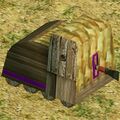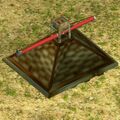Siege Ram
From Warbirth Wiki
|
"Great engines crawled across the field; and in the midst was a huge ram, great as a forest-tree a hundred feet in length, swinging on mighty chains." |
|
|
—'John Ronald Reuel Tolkien, The Return of the King (cap IV, "The Siege of Gondor") |
.
In game[edit | edit source]
| Siege Ram — Vital statistics | ||||||||
|---|---|---|---|---|---|---|---|---|
|
Upgrade / replacement of Battering Ram. Heavy siege weapon specialised in destroying Towers and Forts, impervious to missiles but vulnerable to heavy weapons and melee attacks.
| ||||||||
| Prereq: | Build time | HP | LOS | Attack | Attack speed | Movement speed |
Upgrade of | |
| 12.5s (250t) |
265 | 5 | 43 | 3.3s (50t) |
19 | |||
| Cost | Created from | Armour | Weapon range | Specialty | ||||
| Base | Ramp | Pop | ||||||
| 2 | 8 | 1–2 |
| |||||
Overall Strategy[edit | edit source]
If there was one unit that could be considered as overpowered, it would be the Siege Ram. Not only does it have an anti-building defence bonus like its precursor, the Siege Ram, it also has added attack, hitpoints and armour. Think of them as "war elephants" for use against buildings as they can be used to soak up damage even as they deal heavy damage versus enemy buildings and units alike thanks to their added splash damage as well as their increased attack against buildings.
They are still vulnerable, however: like Battering Rams, they are vulnerable to other siege weapons as well as war elephants. Even lowly Scorpiones can do some serious damage to a Siege Ram, leaving them highly exposed for a finishing blow by other units. In addition, their slow speed and low LOS also make them very vulnerable to Spies - a diversionary attack, followed by a rash of agents fomenting defections can usually do a great deal of damage, especially since Siege Rams are so costly and difficult to build. Otherwise, infantry spam can slow them down, although axe-armed units are the best candidates for this job, owing to the Siege Ram's minimum range, and axemen's ability to inflict armour-piercing damage.
Unit summary[edit | edit source]
- Built to Kill — Siege Rams are highly effective against buildings and can resist archer fire, but are costly and also lack mobility.
- Not Invincible — Use elephants or siege weapons to counter Siege Rams, or otherwise use axe infantry to slow them down.
Notes[edit | edit source]
Early version used by Assur and other contemporary civs.
Early version used by Assur and other contemporary civs.
History[edit | edit source]
The Battering Ram was used to literally 'batter' down, pound, punch and shake castle gates, doors and walls, but in order to do so, up to 100 might be involved and skill was required in timing the rhythmic movement, the swing and twist of the ram in the sling. Left out in the open against archer and slinger fire, however, this could pose problems as the soldiers involved in ramming were left out in the open. One of the solutions that the Assyrians engineered was to enclose the ram within a mobile covered framework, with ramparts for archers and other missile infantry stationed on top of the ram, turning it into a mobile firebase as well as a possible form of siege tower (although other friezes recovered from Nineveh and other Assyrian sites also show escalades were still used to defeat fortified cities).
Such a war machine would have been very effective, but costly to build. This technology was later improved on by the Greeks — most notably the Macedonians, who developed a more practical and lighter form of battering ram, known as a trupanon ("drill"; "borer"). However, the Greeks did not stop there: various sources, including the famous Roman engineer Vitruvius Pollio, described a siege machine, known as the "tortoise" some decades after Alexander the Great's reign, by the Byzantine engineer Hegetor: it consisted of a wooden frame with wheels, protected by a mantlet with a tower at the top from which was chained a massive wooden beam meant for attacking walls, while the mantlet also functioned as a turret carrying light artillery. As impressive as it was, Hegetor's "tortoise" (as it is known to us today) was however too unwieldly and costly — battering rams encased in mobile wooden sheds remained in use all over the Old World for almost a thousand year or more after Hegetor until the introduction of gunpowder artillery.
References[edit | edit source]
- Campbell D; Greek and Roman Siege Machinery; (2003) Osprey Publishing
- Campbell JB & Smith A; Greek and Roman Military Writers: Selected Readings
- Coetzee D; Philosophers of War: The Evolution of History's Greatest Military Thinkers
- Castles, Battering Ram



